 Casey Schmitt kicked off the week with a discussion of doing research in Seville, Spain. Hannah Bailey continued our forum yesterday, with a discussion of research in France. I’m going to continue the conversation with reflections on doing research in London. (For those interested in research gear, see my post from last summer.) Since there are quite a few archives libraries and archives that are potentially of interest to Early Americanists, I will primarily focus on the logistics, such as navigating London and finding accommodations. I’ve provided basic information on a few major archives near the end.
Casey Schmitt kicked off the week with a discussion of doing research in Seville, Spain. Hannah Bailey continued our forum yesterday, with a discussion of research in France. I’m going to continue the conversation with reflections on doing research in London. (For those interested in research gear, see my post from last summer.) Since there are quite a few archives libraries and archives that are potentially of interest to Early Americanists, I will primarily focus on the logistics, such as navigating London and finding accommodations. I’ve provided basic information on a few major archives near the end.
Before You Go:
Documents: Many of the larger UK archives will ask researchers to provide both proof of residence and a photo ID. Some repositories may want to see a letter of introduction, which introduces you as a scholar and briefly summarizes your research. This letter should be on departmental letterhead, and come from your supervisor if you are a grad student, or your chair (or a colleague) if you have finished your PhD. You may also be asked to provide passport photos for your reader’s card, so it may be worth having some taken before you leave.
Accessories: If you are using a digital camera, I also recommend purchasing extra batteries and memory cards in advance of your trip. It will be less expensive than having to do it in London. Consider purchasing a plug adaptor. (Note: most laptops, tablets, cell phones, and Mp3 players will tolerate the higher London voltage, but the adaptor will not convert the voltage. For high-energy devices like hair dryers or electric shavers, I recommend buying a UK appliance once you get to the UK. Many converters do a poor job of converting for these devices, and no one wants their day to start in a rain of sparks.) If forget adaptors, you can purchase them inexpensively in Boots – the chain is ubiquitous in London, but among other places, there is one in the strip mall a few blocks from the National Archives.
Navigation: It may also be worth purchasing a copy of London A to Z, which is an atlas of London.
Money: Note that many British retailers now require a credit card with a chip and pin (or EWV system) and may no longer accept older “swipe” cards. UK ATMs (called “cash points”) accept most debit cards, and frequently, cash withdrawals will give you the best exchange rate, but check with your bank about fees before you go. It is wise to start off with about £50 in cash before you leave, just to cover any initial expenses before you have a chance to get cash.
Safety: For the most part, London is a very safe city. I have walked around at night, by myself, with no problems. Just be mindful of your surroundings. As is typical of larger cities, London does have a problem with pickpockets. There have also been some incidents of people having their smart phones snatched, so it may be for the best to keep it tucked away in public. Get yourself a secured pouch or slash-proof bag to store your cash, credit cards, and documents. (For women; some unisex options; and if you really want to make sure no one’s going to go digging, behold the anti-theft underwear!)
Finding Accommodations:
Among the biggest challenges is that London is a very expensive city, and academic schedules mean that research trips take place during peak season, when air fares and accommodations are at their most expensive. Planning well ahead can save you a lot of money. The more desirable accommodations can be booked up as early as March.

Click here for a larger map of the London Underground (or Tube).
Let me start first by discussing transportation around London. After you have cleared Customs (Global Entry recommended), you have a few options for getting into central London. While the thought of pouring yourself into a cab to go right to your destination might be tempting – especially if you’ve come in on a red eye flight – you should be aware that cabs are very expensive. You could easily wind up with a £140 (approx. 200 USD) cab fare (plus tip – tipping is less common in the UK, but a 10% tip on a cab fare is expected). The least expensive option is to take the Tube right from the airport. You can purchase an Oyster Card (the stored value ticket) at the airport, but the line (queue) can be long. You may wish to order one from in advance of your trip. I recommend a starting balance of at least £30. You can add money to your Oyster Card later. You can also take the Heathrow Express to Paddington Station, and either take a cab or the Tube to your final destination. From Gatwick Airport, take the Gatwick Express to Victoria Station, and then you have a choice of bus and Tube options to your accommodations. Some Tube Stations do have a lot of stairs, so be mindful of that when packing. While you are in London, the Tube will likely be your primary source of transportation. (Point of London etiquette: Make sure you stay to the right on all stairs. Point of safety for many of those coming from outside Britain: Don’t forget to look to your right before stepping into cross walks.) Note that some local city buses may have stops a block or so outside of major stations. There will often be an information board near bus stops where you can look up bus routes and stops by your destination.
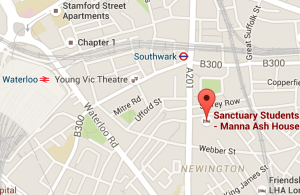
Manna Ash is only 2 blocks from the Southwark Tube Station and 10 minutes from Waterloo. There is Marks and Spencer Simply Food in Waterloo Station and a small Tesco right across the street.
Accommodations can depend both on which archives you need to visit, the length of your stay, and your budget. Having access to kitchen facilities can be a big savings. I brought peanut butter and jelly sandwiches for my lunch most days, and frozen meals from Marks and Spencer Simply Food for dinner. Researchers who will primarily be based at the National Archives will want to check out the Kew accommodations website, which is a list of Kew-adjacent residents who let out a room or in-law flat in their private homes. Those whose research endeavors will keep them closer to Central London have a couple of options. The first is that many London universities rent out rooms in their residence halls during the summer months. On one of my trips, I stayed at the University of the Arts’ Manna Ash House, which is located just a few blocks from the Southwark Tube Station and about a 10 minute walk from Waterloo Station. It is a secure building. The rooms have kitchen and laundry facilities, as well as private ensuite bathrooms. It is also walkable to the Lambeth Palace Library and the Parliamentary Archives. Other options include Doctor in the House (essentially, Air BnB for academics), AirBnB, or Rentalo (which also offers apartment rentals). Note: Some accommodations have free wireless or offer wireless for an additional cost, but there are also internet cafes all over London, where you can access the internet inexpensively.
When You Arrive:
Transit: Familiarize yourself with the Tube. If you have purchased an Oyster Card in advance, top it off with enough of a balance to last you a week so that you avoid rush hour queues at the stations. As noted above, cabs are very expensive and should be used sparingly, if at all.
Phones: These days, most cell phones are unlocked, and many offer international plans. Call your provider to determine which data plan is best for you. You can also buy a UK SIM card and swap it out. If you are in London for more than a few days, you may find it more cost-effective to buy a basic disposable cell phone. Carphone Warehouse has a wide range of carriers (including pay-as-you go SIM cards) and a number of locations around the city. Some plans will let you call back to the US and Canada for a few pence a minute at certain times a day. Consider what you need in terms of minutes and data. You can buy smart phones, but I usually just purchase a plan for calls and texting.
Food: London is awash in great restaurants and pubs, but research budgets rarely permit eating out every day. Making your own food (self-catering) is among the better cost-saving measures. The main supermarket chains are Tesco, Sainsbury’s, and Waitrose. Waitrose is usually the most expensive of the three. I have found that Sainsbury’s has the best variety. As noted above, you can also purchase prepared meals at Marks and Spencer Simply Food (or Pret-a-Manger). Boots Pharmacy is usually the best place to purchase toiletries.
Archives:
This is not an exhaustive list, but notes a few major archives that may be of particular interest to Early Americanists. Please note that all fees in the descriptions below are accurate as of June 2017. You should be prepared to pay any photography or other research-related fees in cash. UK ATMs accept most American debit cards, and cash withdrawals often have the most favorable exchange rates, but you should verify fees with your home bank before you go (and also inform them that you will be in the UK).

For walking directions from Kew Gardens Station, click here.
National Archives (Open Tues. – Sat.; see website for details)
Nearest Tube Station: Kew Gardens (District Line)
Online Catalog: Discovery (You can also find records from archives around the UK.)
Notes: While you don’t need an appointment, it is important to get there right at opening to secure a spot during peak summer months. If it is your first time, or you haven’t been in a while, you will need to register for a reader’s card. You will need a photo ID and separate proof of address. Flash-free photography is permitted as preservation allows. The NAUK has a limited number of photography stands for researcher use. Free wifi is available. There is a cafe onsite.
 The Discovery catalog gives you two options. The first allows you to limit your search to NAUK holdings (Discovery is a central catalog that will allow you to search multiple UK archives at once). The second allows you to limit your search to documents that have already been digitized. Your search results will include a call number that tells you the record group and manuscript ID. For example CO = Colonial Office. TS = Treasury. HCA = High Court of Admiralty. SP = State Papers. There is a menu to the left that lets you filter your results by year range, record group, geographic location, etc. Click on individual manuscript numbers to request retrieval of documents. If you don’t have an active reader’s card, you can still complete a preliminary registration online and order some of your materials in advance. They will be brought up for you when you finish registering.
The Discovery catalog gives you two options. The first allows you to limit your search to NAUK holdings (Discovery is a central catalog that will allow you to search multiple UK archives at once). The second allows you to limit your search to documents that have already been digitized. Your search results will include a call number that tells you the record group and manuscript ID. For example CO = Colonial Office. TS = Treasury. HCA = High Court of Admiralty. SP = State Papers. There is a menu to the left that lets you filter your results by year range, record group, geographic location, etc. Click on individual manuscript numbers to request retrieval of documents. If you don’t have an active reader’s card, you can still complete a preliminary registration online and order some of your materials in advance. They will be brought up for you when you finish registering.

For walking directions from King’s Cross/St. Pancras Station, click here.
British Library (Open Mon. – Sat.; see website for details)
Nearest Tube Station: King’s Cross/St. Pancras (Piccadilly or Victoria Lines)
Online Catalogs: Variable
Notes: The main branch is the St. Pancras location. You will need to register for a reader’s card in advance. Bring a photo ID and a separate document with proof of address. As with the National Archives, you should plan to get there early during peak summer months. Note that the BL has 11 reading rooms that specialize in different areas. You may need to change reading rooms, depending on what you are looking at. Flash-free digital photography is permitted, but researchers should get the reference staff’s permission on individual manuscripts first. Wireless access is available for registered readers, and the Library has recently added eduroam. There are lockers downstairs for your belongings. There is a cafe and restaurant onsite.
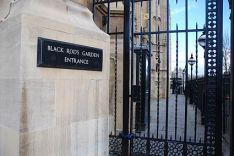
Black Rod’s Garden Entrance. For walking directions from Westminster Station, click here.
Parliamentary Archives (Open Mon. – Fri.; by appointment only)
Nearest Tube Station: Westminster (District and Circle Lines)
Online Catalog: Portcullis
Notes: Researchers need to make an appointment at least 2 working days in advance. Plan further ahead during busy summer months. Entrance is through the Black Rod’s Garden Entrance unless otherwise instructed. A photo ID is required for entry. Security is tight, so expect to go through a screening and to wait for an escort to and from the reading room. Flash-free photography is permitted for a fee of £7.50 per day. The reading room has free wireless for researchers with their own laptops.
Portcullis, the Parliament Archives’ catalog allows researchers to search via keyword and by record group. You can also narrow your search by date range.
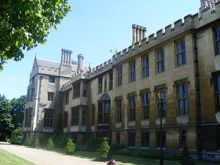
For walking directions from Lambeth North Station, click here.
Lambeth Palace Library (Open Tues., Weds., Fri – 10-4; Thurs., 10-7:30)
Nearest Tube Station: Lambeth North (Bakerloo Line)
Online Catalogs: Variable
Notes: The Lambeth Palace Library is the Library of the Archdiocese of London. A photo ID and proof of address (must be separate documents) are required. I recommend emailing in advance to request records. You will need to apply for a reading ticket on your first visit. It is valid for two years thereafter. Flash-free digital photography of materials is permitted as preservation allows, but photographic equipment must be completely silenced. There is a daily photography fee of £5.
As with the British Library, most researchers will primarily use the manuscripts and archives catalog. The interface is very similar to the one used by Parliamentary Archives, but also has an option to search their Names and Places databases.

For walking directions from Eustace Square Station, click here.
Wellcome Library (Open Mon.-Sat.; see webpage for hours)
Nearest Tube Station: Euston Square (East London, Hammersmith & City, and Metropolitan Lines)
Online Catalogs: Variable
Notes: The Wellcome Library’s strength is in the History of Medicine. It is possible to pre-register ahead of your visit, so that you can request research materials in advance. If you join the library (free), your membership card will be good for 5 years. Proof of address and a photo ID (separate documents) is required, and you will need to fill out an application form and agree to their terms of use and computer usage policy. Flash-free digital photography may be permitted for some materials, but must be discussed on a case-by-case basis with the reference staff. Registered users have free access to the Library’s wireless network. You can also print shorter documents remotely from your own laptop for a fee of 5p per page. See here for a discussion of printing services.
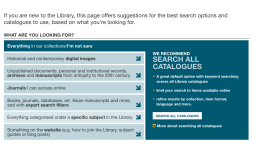 Wellcome’s interface is very user-friendly and allows researchers to select from different catalogs. They provide a guide to help researchers decide which catalog to use, or an option to search across multiple catalogs simultaneously.
Wellcome’s interface is very user-friendly and allows researchers to select from different catalogs. They provide a guide to help researchers decide which catalog to use, or an option to search across multiple catalogs simultaneously.
School of Oriental and African Studies – U. College of London (Opening Times, Mon. & Tues. 9-5; Thurs & Fri. 9-5. Closed Bank Holidays)
Nearest Tube Station: Russell Square (Piccadilly Line)
Online Catalogs: Variable
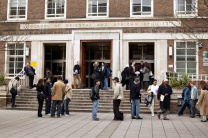
For walking directions from Russell Square Station, click here.
Notes: The School of Oriental and African Studies Library (aka SOAS) has strengths in collections documenting Britain’s interactions in Africa, Asia, the Middle East, as well as in Missionary History. You will need to apply for access. Bring proof of identity, proof of address, and documentation of your affiliation (a letter from your chair and faculty or student ID). You can request up to three documents in advance, even if you have not registered. After those three, you must complete researcher requests in person at the reading room supervisor’s desk.
There are lockers in the hallway just outside of the reading room. The supervisor will give you a key when you sign in and present your ID. There is free wireless access. You will need to leave the library for meals. There is both a Tesco Express and a Pret-a-Manger between the Russell Square Tube stop and SOAS, so you can purchase a meal and eat it outside if it’s a nice day.
Are there other London area archives you’ve used? Share your tips below?
There’s some great advice here. I would add:
If you’re going to be in London for a week or more, it’s probably cheaper to get a weekly (or monthly) option put on your Oyster card rather than to pay as you go. You should see both options on the automated screen. Look up your lodging on a Tube map before you go so that you know what zone you’re in; weekly/monthly fees change based on zone.
Even if your phone doesn’t work in the UK, Google Maps still should. Just look up your route when you have a Wi-Fi connection. Even once you’re disconnected from the internet, your GPS will continue to work and you should not be charged for data. Very handy for London, when following the Thames does not guarantee your ability to know where you are.
For the National Archives, you will not be able to electronically request documents from your own computer. If you already have a reader’s ticket you can email to request documents ahead of time, but for the most part document requests need to be placed on a Kew computer in the reading rooms.
Thanks, Rachel! Forgot to mention that! When I was there in 2014, they were talking about making an adjustment to their system to allow researchers to electronically request documents from your own computer. Any idea if that’s (still) in the works?
Not sure. Their system is easy enough to use, as long as you know how it works ahead of time. It’s also nice that you can go up to any one of those machines and scan your card, and they’ll tell you if your documents are in yet or not
It’s definitely easy enough to use. I was sort of wondering if the comments from the NAUK staffer were more reflective of wishful thinking. It was July. The reading room was very busy, and he may have been tired of navigating disputes over who was “hogging” the terminals. (Normally people are pretty good, but there were a couple of inconsiderate researchers that day.)
A £140 taxi ride?! What taxi did you or someone you know get?!
I’ve flown into Heathrow a few times. The most expensive ride I had was £70, thanks to pretty bad traffic on the way into central London.
It was me. I’ve taken Black cabs from Heathrow twice, either because of the hour I arrived or the luggage I had with me. First time I arrived it was after 11 pm when I cleared customs. I took a cab from Heathrow to Manna Ash (mentioned above) and it was around £70. (This was 2008.) Last time, I had a red eye and had not slept a wink due to overheated plane and a drunk passenger snoring loud enough to keep all of economy class awake. At that point, I hadn’t slept in about 38 hours and was so exhausted that the thought of navigating public transit was painful. Cab from Heathrow to my accommodations in Camden Town was £140. (This was in 2014.) I was expecting it to be £70, or I would have made myself suck it up. (Meanwhile, a Black cab from Paddington Station to my accommodations in Camden Town was only £12.)
How upsetting! I once had to pay $80 + tolls to get from Newark airport to W 77th and Amsterdam–I thought that was too much!
Yeah, I expected fare to be slightly higher since it was daytime versus 11:30 at night (my first arrival), but that was a shock. I wasn’t pleased, but of course, nothing to do but pay the cabbie at that point. It was post rush hour by the time I cleared customs, so traffic wasn’t even that bad relative to London. Certainly nothing close to £70 more’s worth of traffic over my last visit. I wouldn’t take a cab from Heathrow again outside of really extraordinary circumstances.
Just wanted to point out also that if you have a smartphone on the basic T-Mobile plan, you get unlimited (but very slow) data roaming. It’s the main reason I switched and it has saved me much $$$ during research trips out of the US.
Oh, and, of course, thank you so much for this! Practical archive posts are among my absolute favorite types of Junto posts.
Yes, thank you. A friend had similar luck with Sprint, I think, though he may have paid for a limited international data plan through his provider. I thought about switching, but neither network has very good coverage in my neck of the woods.
Pingback: Non-Americans Researching Early America in North America « The Junto
Not London, but related: many other Universities in the UK also rent out space in student accommodation, during the summer or academic year. I was able to get a studio apartment like self-catering room from the University of Liverpool for under $200 for a *week* when I was researching in Liverpool in June 2013. So always check the local Universities!
Absolutely. Doctor In The House offers listings in Edinburgh. And, there is an unofficial list of researcher lodgings (similar to Kew Accommodations) for those needing to do research in Oxford. The name is escaping me, but I’ll try to find it and post it later.
Pingback: Junto Roundtable on Atlantic Archives – Professor Park's Blog
Thank you for the post, you helped me a lot.
Pingback: Research at the Bodleian: a Guide « The Junto
Thanks for the informative post. Another useful location to know about is the Institute of Historical Research next to the British Museum, with its library (and North America Room), tea room, and its series of seminars (during term time) — a good way to make the visit more sociable. Bring ID and proof of address for library membership. http://www.history.ac.uk